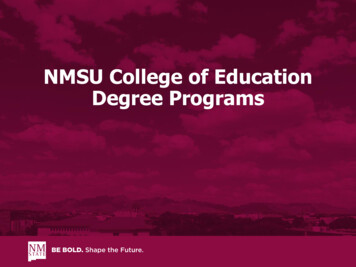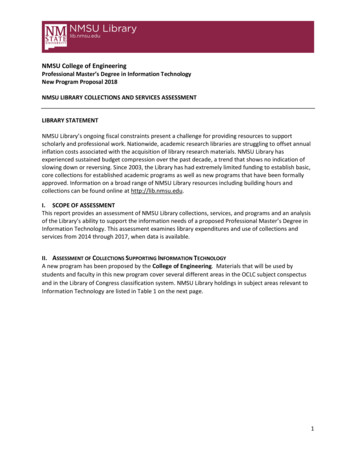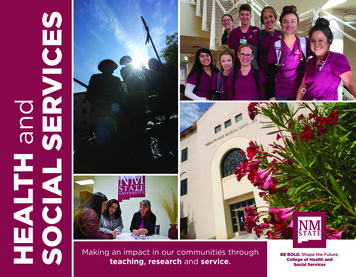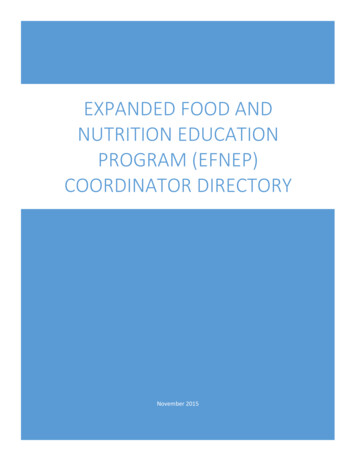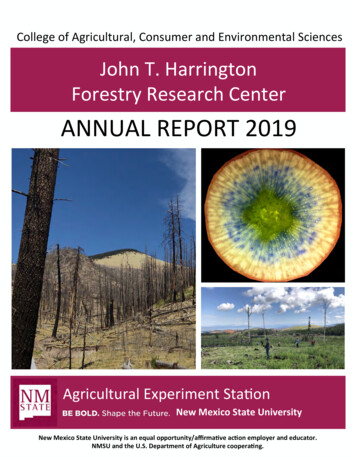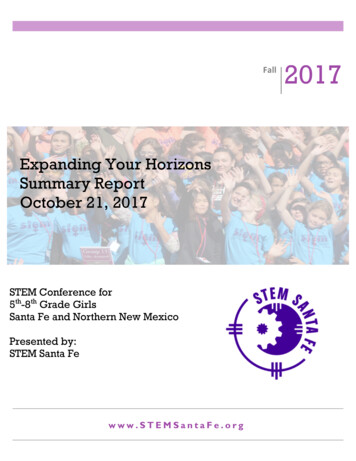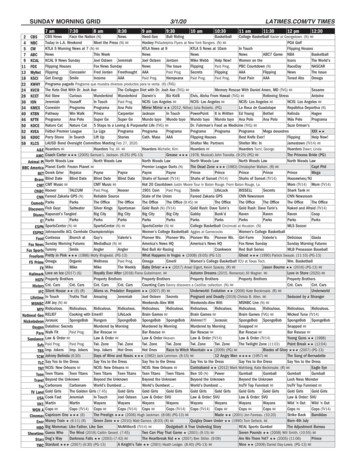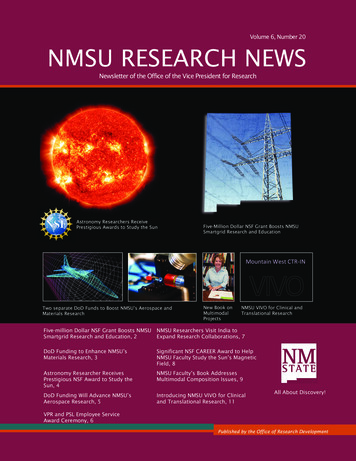
Transcription
NMSURESEARCHNEWSNMSU RESEARCH NEWSVolume 6, Number 20Newsletter of the Office of the Vice President for ResearchDepartment of Energy Awards 5 Million Grant toContinue NMSU Algal Biofuel ResearchAstronomy Researchers ReceivePrestigious Awards to Study the SunFive-Million Dollar NSF Grant Boosts NMSUSmartgrid Research and EducationMountain West CTR‐INTwo separate DoD Funds to Boost NMSU’s Aerospace andMaterials ResearchNew Book onMultimodalProjectsNMSU VIVO for Clinical andTranslational ResearchFive-million Dollar NSF Grant Boosts NMSUSmartgrid Research and Education, 2NMSU Researchers Visit India toExpand Research Collaborations, 7DoD Funding to Enhance NMSU’sMaterials Research, 3Significant NSF CAREER Award to HelpNMSU Faculty Study the Sun’s MagneticField, 8Astronomy Researcher ReceivesPrestigious NSF Award to Study theSun, 4NMSU Faculty’s Book AddressesMultimodal Composition Issues, 9DoD Funding Will Advance NMSU’sAerospace Research, 5Introducing NMSU VIVO for Clinicaland Translational Research, 11All About Discovery!VPR and PSL Employee ServiceAward Ceremony, 6Published by the Office of Research Development
Left to right: Louiza Fouli (Mathematical Sciences), Jay Misra (Computer Science), Susan Brown (Director of NMSU’sSTEM outreach program), Enrico Pontelli (Computer Science), Sukumar Brahma (Klipsch School of Electrical andComputer Engineering), Satish Ranade (Klipsch School of Electrical and Computer Engineering), and Son Tran(Computer Science). Not pictured: William Yeoh and Huiping Cao from the Department of Computer Science.Five-Million Dollar NSF Grant BoostsNMSU’s Smartgrid ResearchBy Hamid Mansouri Rad, Office of Research Development (ORD)An interdisciplinary team of NMSU scientistswere awarded 5 million by the NationalScience Foundation to enhance NMSU’sresearch and education on smartgrids.Through this project, entitled the Interdisciplinary Center of Research Excellence in Designof Intelligent Technologies for Smartgrids(iCREDITS), NMSU scientists from the departments of Computer Science and Klipsch Schoolof Electrical and Computer Engineering willcreate a new center for research and training insmartgrids. The project’s main objectivesinclude creating infrastructure to enableinterdisciplinary research and training insmartgrids, developing research to realize an energydelivery paradigm and sustain the designand development of smartgrids, developing a comprehensive interdiscipliNMSU RESEARCH NEWS 2nary training pipeline in smartgrids, promoting participation of a diverse studentpopulation in smartgrids training andresearch, and achieving international leadership in smartgrids research and training.This effort is co-directed by two prominentNMSU researchers, Drs. Enrico Pontelli, Chairof the Department of Computer Science, andSatish Ranade, Chair of the Klipsch School ofElectrical and Computer Engineering. Althoughawareness is increasing regarding the need foralternative sources of energy, and we see morebuilding structures equipped with solar panels,according to Satish Ranade, that is not enough.“In the U.S. we use about 3,500 watts per person, whereas the developing countries use 500watts of energy per person,” he said in aContinued on page 10
Department of Defense Funding to EnhanceNMSU’s Materials ResearchBy Hamid Mansouri Rad, ORDLeft to right: Stefan Zollner, Edwin Fohtung, and Heinz Nakotte (Department of Physics); Hongmei Luo andShuguang Deng (Department of Chemical Engineering)A team of faculty led by Dr. Stefan Zollner,professor and head of NMSU’s Department ofPhysics, has been awarded a 300,000 grant bythe Department of Defense for acquisition of ahigh-resolution, high-power X-ray Diffractometer (XRD) for materials research and education. This instrument will replace an olderpowder diffractometer with lower resolutionand intensity. The team also includes Drs.Heinz Nakotte and Edwin Fohtung (Physics)and Shuguang Deng and Hongmei Luo(Chemical Engineering).“I commend Dr. Zollner for his efforts tosecure this award,” says Vice President forResearch Vimal Chaitanya. “Once operational,this XRD will fill a gap that our researcherspresently have in order to become morecompetitive in pursuing research endeavors inmaterials science and engineering.”While housed in NMSU’s Gardiner Hall,home of the Department of Physics, the XRDwill be made available to all researchers oncampus. The instrument will be integrated intothe Core University Research ResourcesLaboratory (CURRL).Recognizing the national need for highlyskilled scientists and engineers, the Department of Defense has awarded more than 1.7million in grants and contracts to the NMSUDepartment of Physics. These funds are usedto train undergraduate and graduate studentsand to acquire equipment.For more information, please contact Dr.Zollner at zollner@nmsu.edu.High-resolution, high-power X-rayDiffractometerNMSU RESEARCH NEWS 3
Astronomy Researcher Receives Prestigious NSFAward to Study the SunHamid Mansouri Rad, ORDDr. James McAteer, assistant professor ofAstronomy, has received 750,000 fromthe National Science Foundation’s highlycompetitive Faculty Early Career Awardprogram to continue his research on the Sun.Dr. McAteer’s project entitled “INSPIRE:An Integrated Solar Physics Program inResearch and Education” addresses twofundamental questions about the Sun: how is theSun structured, and how and why does the Sunvary.“The topic of the Sun’s structure andevolution provides multiple research topics forboth PhD students in astronomy andundergraduate students across Science,Technology, Engineering, and Math (STEM).”As such, this project allows NMSU studentsfrom across all STEM fields to participate inresearch. “This encourages participation fromstudents who otherwise may have never considered scientific research as a component of theirdegree,” says Dr. McAteer. Further, the modularnature of this project allows for work to be combined into graduate research of a truly interdisciplinary nature.The project provides research opportunitiesfor ten undergraduate and four to six graduatestudents. Each student will have a chance topresent his or her work extensively in nationaland international astrophysics and interdisciplinary conferences and refereed journals.As part of the project, Dr. McAteer ispartnering with a solar physics citizen-scienceproject, Zooniverse, and developing andintegrating team-based learning initiatives intohis classroom. He will provide scientific input,and use the scientific outputs in addressing theresearch objectives of this project. TheNMSU RESEARCH NEWS 4Dr. James McAteer explaining his project during anNMSU research rally held at NMSUintegration of research and education is a key component of the NSF Career program.Before joining the NMSU faculty, Dr.McAteer was a fellow at Trinity College (Dublin),NASA’s Goddard Space Flight Center, andQueen’s University in Belfast.Dr. McAteer joined NMSU in 2010 and is amember of the Solar Physics and Space Weatherresearch group in the Department of Astronomy.For additional information, please contact Dr.McAteer at mcateer@nmsu.edu.
DoD Funding Will Advance NMSU’s Aerospace ResearchHamid Mansouri Rad, ORDDrs. Young S. Lee, Fangjun Shu, and MingjunWei, faculty members of the Mechanical andAerospace Engineering (MAE), have beenawarded a 500,000 grant by the US Army Research Office for acquisition of a Polytec PSV500 scanning vibrometer, a LaVision timeresolved 3D PIV system, and an ATOS coreessential 2MP 3D scanner. This equipment willfacilitate NMSU faculty’s research in multidisciplinary areas such as fluid-structure interactionin flapping wings of a bio-inspired micro-airvehicle. According to Dr. Lee, they will also beused as a teaching and demonstration tool, making the learning process more interactive throughmore realistic visualization of mechanical principles in 3D.These three instruments, as shown below,will be integrated into a system for laser-assistedmodeling of structural/fluid dynamics and fluidstructure interaction problems.Once acquired, the three instruments will beinstalled in the Aerospace Structural DynamicsLaboratory, the Aero/Fluid Laboratory, and theLeft to right: Mingjun Wei, Young S. Lee, andFangjun Shu at a research rally honoring theirsuccess in securing the DoD instrumentationfundingComputational Fluids Dynamics Laboratory, alllocated at NMSU’s Jett Hall, home of MAE. Inaddition to MAE faculty members, the equipment may be used by faculty in the Departmentsof Civil Engineering, Industrial Engineering,Chemical Engineering, and Engineering Physics.For more information, please contact Dr.Lee at younglee@nmsu.edu.Structural DynamicsSchema c of the integratedsystem for laser‐assisted non‐intrusiveexperimenta on and data‐drivenreduced‐order modeling of fluidstructure interac onsExperimental Fluid DynamicsComputa onal Fluid DynamicsMode 1Polytec Scanning LDV SystemMode 1Data‐Driven Reduced‐OrderModelingCapture 3D Scanner SystemLaVision 3D PIV System
VPR and PSL Employee Service AwardsBy Hamid Mansouri Rad, ORDEmployees of the Office of theVice President for Research andPhysical Science Laboratory(PSL) who completed a serviceanniversary in 2013 were recognized at a ceremony in AndersonHall. Reminiscing about his firstjob at NMSU as a PSL studentemployee assisting with missiletesting data analysis 50 years ago,President Carruthersmentioned that he is intimatelyfamiliar with the work PSL does.“The greatness of PSL, andNMSU in general, is sustained bypeople who have worked hereover a long period of time,” hesaid. “That is why we honor thosewho have worked here for 5, 10,15, 25, and 35 years at NMSU,one of the finest land-grantuniversities in the country.”PSL was founded in 1946 toaddress the needs of the nation’sspace and rocket initiatives. Thestaff at PSL played a crucial rolein testing and analyzing dataregarding the V-2 and the Aerobee rocket at the White SandsMissile Range. By the 1970s, PSLexpanded its customer base to theU.S. Air Force and NASA.PSL continues its support ofNASA’s unmanned, high altitude(120,000 ft.) scientific balloonoperations and manages theColumbia Scientific BalloonFacility in Palestine, Texas. PSLalso supports the Department ofDefense in the areas of telemetryand unmanned aerial vehicle systems (UAS) flight and testing.PSL manages the UAS FlightNMSU RESEARCH NEWS 6Left to right: Cristina Briones (PSL), Alfredo Montoya (Compliance), Yesenia Luna (Research Development), Cherri Lambeth (Business and Resource Planning), Barry Hudy (PSL), Vice President for Research VimalChaitanya, President Garrey Carruthers, Steve Benavidez (PSL), LuisSchrader (PSL), Steve Hottman (Director, PSL), and Vicki Morgan(Grants and Contracts). See opposite page for employees not in the picture.Test Center that covers 15,000 square miles of airspace over ahighly varied train in the southwest U.S. “With over 300 employees, PSL is an asset to NMSU and to the nation, and we continue toAn unmanned aerial system being controlled by a PSL employeeat the UAS Flight Test Center.
support its operations,” says VPR Chaitanya. InFY 2013 PSL garnered in excess of 43 million inexternal funding.Employees not picturedPhysical Science Laboratory Alexander Beange, Electrical Engineer, Columbia Scientific Balloon Facility (CSBF)Catherine Bryant, Quality Assurance Technician,CSBFDonald Bunt, Electrical Technician, CSBFMargaret Campos, Engineer, 21st Century AerospaceNancy Caudle, Buyer, CSBFDarla Cook, Sr. Admin. Assistant, CSBFGregory Cooper, Data Security Analyst, PSLSecurity Safety ServicesOra Ennis, System Developer, CSBFTravis Farley, Electrical Engineer, InformationSciencesChristopher Field, Engineer, CSBFRonald Frame, Business Manager, CSBFMichelle Gavin, Research Integrity CoordinatorStuart Head, R&D Engineer, 21st Century AerospaceJill C. Juneau, Engineer, CSBFSergey Klypin, Electrical Engineer, InformationSciencesBobby Lucero, Manager, Facilities ServicesOtto Masters, Balloon Tech Mechanic, CSBFSteven McGee, Software Developer, InformationSciencesFernando Moncayo, Electrical Engineer,Information SciencesJonathan Newton, Software Developer,Information SciencesKathleen Rodriguez, Accountant, ResearchCenterAbel Sanchez, Director, Computer SupportChristopher Sanchez, Electrical Engineer,Information SciencesChristopher Schwantes, Meteorologist, CSBFErnest Serna, Security Guard, Anderson HallDavid Webb, Electrical Technician, CSBFOffice of the Vice President for Research Richard Hummell, Contract Administrator,Office of Grants and Contracts (OGC)Sudha Murthy, Director, Office of ResearchDevelopmentRita Parra, Contract Administrator, OGCFrank Utecht, Contract Administrator, OGCNancy Treffler-McDow, Admin Assistant,Molecular Biology ProgramNMSU Researchers Visit India toExpand Research CollaborationsBy Hamid Mansouri Rad, ORDIn January, Vice President forResearch Vimal Chaitanya alongwith faculty members Jeffrey Arterburn, Regents Professor of Chemistry and Biochemistry; Brad Shuster,Associate Professor of Biology;Ross Staffeldt, Professor of Mathematical Sciences; and Jay Misra,Assistant Professor of Computerscience; visited several outstandingeducational institutions in India toexpand NMSU’s collaborations withthat country.“The goal of these visits was tofurther explore areas of collaborations with Indian educational institutions that offer capabilities that arecomplementary to those of NMSU,”says VPR Chaitanya.NMSU delegation visitedIndian Institute of Science Education and Research (IISER) in Puneand met with the IISER administration and faculty members. They alsovisited several research labs andmade technical presentations.During these visits many avenues ofpotential collaboration were discussed. Among them was a shortterm and long term (10 months) exchange of students who are engagedin research activities as well as feasibility of faculty exchanges anddoctoral study opportunities atNMSU.Drs. Chaitanya and Misra alsovisited Maharaja Sayajirao University (MSU) in Baroda and IndianInstitute of Technology in Bhubaneswar. They discussed the possibility of accepting some of their topstudents to NMSU graduateprograms and initiating researchContinued on page 10JeffreyArterburn,Chemistry &BiochemistryVPR VimalChaitanyaJay Misra,ComputerScienceBradShuster,BiologyRoss Staffeldt,MathematicsNMSU RESEARCH NEWS 7
Dr. Jason JackiewiczSignificant NSF CAREER Award to Help NMSUFaculty Study the Sun’s Magnetic FieldBy Hamid Mansouri Rad, ORDNMSU Astronomy Assistant Professor JasonJackiewicz was granted a highly competitive 600,000 National Science Foundation CAREERaward for his project to study the sun.The scientific goal of this project is to understand how the Sun generates and sustains its ownglobal magnetic field. This will be carried out bystudying the main ingredients of this process,which are the Sun's interior plasma flows that areassociated with its east-west rotation and also theflows that go in the north-south direction to thepoles and equator. These large motions in the Sunare thought to help provide new sources of magnetic-field generation potential, thus creating thesolar cycle and giving rise to the violent magneticeruptions that affect Earth.“We will analyze the interior dynamics ofthe Sun using solar seismology, or helioseismology, which involves studying sound waves in theSun using techniques very similar to what Earthseismologists use for understanding our planet'sinterior from earthquakes,” says Dr. Jackiewicz.“Extending our findings to other stars with magnetic fields will place the Sun in an astrophysicalcontext.”Two graduate students and ten underrepresented minority students will be trained in theproject, giving them the technical experience theyneed to form a diverse, next generation of solarastronomers. In addition, professional developNMSU RESEARCH NEWS 8Dr. Jason Jackiewicz explaining his use of helioseismologyfor studying the Sun’s magnetic field during a researchrally held to celebrate his prestigious NSF award.ment activities with sixth-grade teachers in southern New Mexico promoting relevant inquiry-basedlearning related to project science will help theteam reach about 15,000 students over the nextfive years, leading to increased science proficiency in this critical age group.For more information please contact Dr.Jackiewicz at jasonj@nmsu.edu.
NMSU Faculty’s Book Addresses MultimodalComposition IssuesBy Hamid Mansouri Rad, ORDThe impact of visual, oral, spatial, andcipal concepts used in creatingdigital communication as a means formultimodal projects.crafting and delivering information isDr. Sheppard and hera rapidly expanding area of study forco-authors have been fascinatedrhetoric scholars. Just as print hadwith the intersection of writingenormous social impact by allowingand technology since their daysmass dissemination of books and othertogether in graduate school.printed materials, desktop publishing“During our time as PhD studentsand now new media have revolutionand in our separate careers, weized production of multimodal proeach have taught various digitaljects. Digital technology has allowedrhetoric, multimedia development,authors to easily create and incorpoand electronic publishing courses,rate visuals and sounds in a variety ofbut we were never able to find amaterials, from marketing to complextextbook that struck a happyDr. Jennifer Sheppard,technical documents, in order to immedium between interpretingAssociate Professor ofprove readers’ understanding of thetheory for students and helpingEnglishcontent provided to them. Despite thisthem to put it into practice nodigital revolution, rarely do facultymatter what genre or audienceacross disciplines allow use of multithey were writing for,” says Dr.ple media in student projects. TradiSheppard. “Our goal for the booktionally, the focus has been on compowas to help authors learn to makesition and content through writtenconscious multimodal choices inwords, and writers were onlythe text they create, no matterpermitted use of text features such aswhat mode, medium, or rhetoricaltype face, weight, decoration, spacing,situation they are working in.”and size to guide readers throughWriter/Designer wasdifferent hierarchies of information onpublished in February of this yeara paper. But the trend is changing.(2014) by Bedford/St. Martin’s.Scholars such as NMSU EnglishThe book provides a set of rhetoriAssociate Professor Jennifer Sheppardcal rubrics for analyzing multirecognize that composition has alwaysmodal projects and presents casebeen a multimodal process requiring usstudies to help the readers examine theseto change how we think about college composiprinciples in action. A chapter is also devottion as well. Nevertheless, if we were to accepted to choosing a genre and thinking aboutand encourage multimodal student projects, that“pitching” a project to stakeholders. In addiincorporate visuals, sounds, or movies, how do wetion, the readers are provided with supportteach them in composition courses? How do weing documents, e-Pages, that can beevaluate them? These questions have driven Dr.accessed online at bedfordstmartins.com/Sheppard and her co-authors to publish the bookwriterdesigner.Writer/Designer: A Guide to Making Multimodal“The audience for this book is anyone,Projects. This book draws from research in comstudent or instructor, who needs to learnposition and the authors’ first-hand experience inpractical strategies for communicatingteaching multimodal classrooms to introduce prinContinued on page 10NMSU RESEARCH NEWS 9
“Five-Million Dollar NSF Grant Boosts NMSUSmart Grid Research” continues from page 2research rally held on April 11 dedicated tothe iCREDITS project. Discussing the needfor comprehensive adoption of alternative energy sources, Ranade said that we need toreach a point where we don’t have to buildpower plants anymore.A smartgrid is a fully automated powerdelivery network that monitors and controlsevery customer and node, ensuring a two-wayflow of electricity and information betweenthe power generators and the appliances andall points in between. The basic principle of asmartgrid is that energy must be generated,not only by power plants, but also by consumers. The grid must constantly have access tolive data regarding power generation andconsumer usage. “The vision of iCREDITS isto obtain sustainable generation capacity byshifting the paradigm from power delivery toenergy delivery, using smartgrid concepts,”said Pontelli. “In an energy-delivery system,energy is viewed as a commodity, which canbe produced, stored, and exchanged. We startthis project locally, but our results are scalableto the national level.”This project also aims to address a fundamental problem, which is dramatic shortage ofworkforce in smartgrids. “The education component of this project will create a comprehensive pipeline starting from K-12 and continuing to the doctoral level, serving an academically and culturally diverse student populationin New Mexico,” said Pontelli.In addition to Drs. Pontelli and Ranade,other investigators collaborating on thisproject are Drs. Jay Misra, William Yeoh,Huiping Cao, and Son Tran from theDepartment of Computer Science, Dr. Suku-NMSU RESEARCH NEWS 10mar Brahma from the Klipsch School ofElectrical and Computer Engineering, SusanBrown, director of NMSU’s STEM OutreachCenter, and Louiza Fouli Assistant Professor ofMathematical Sciences.For additional information pleasecontact Dr. Pontelli at epontelli@cs.nmsu.edu orDr. Ranade at sranade@nmsu.edu.“NMSU Researchers Visit India to ExpandResearch Collaborations” continued frompage 7collaborations with outstanding faculty.The group also gave talks at the Indian Institute of Technology in Indore. They visitedseveral research labs, discussed avenues of collaboration, and met with administrative leadership and faculty members.“NMSU Faculty’s Book Addresses MultimodalComposition Issues” continued from page 9effectively in multiple media,” says Dr.Sheppard. But the book will hold its promisebeyond the classroom, as a reference guide forthose who want to create captivating multimodal projects for work.Writer/Designer can be found onAmazon.com. For additional information aboutthe book, please contact Dr. Sheppard atjasheppa@nmsu.edu.
Introducing NMSU VIVO for Clinical andTranslational ResearchBy Hamid Mansouri Rad, ORDNMSUNMSU is one of the 13 institutions across 7states that are part of the Mountain West Clinical and Translational Research-InfrastructureNetwork (CTR-IN). In order to facilitate collaboration and mentoring across the consortium, the CTR-IN plans to use the VIVO academic profile system, a web application thatallows search and discovery of research andscholarship. NMSU plans to populate VIVOwith profiles of faculty interested in clinicaland translational sciences, irrespective of theirseniority or track record with NIH.The VIVO system will not supplantDigital Measures at NMSU—it is being usedonly for the purposes of identifying CTR-INmentors and collaborators to pursue additionalopportunities in clinical and translational sciences.What is the advantage of VIVO forNMSU? Faculty and researchers who areinterested in translational research can use it asan inter-institutional collaboration explorer.Current faculty who have registered withNMSU VIVO include Jeffrey Arterburn(Chemistry and Biochemistry), Cindy Kratzkeand Kristynia M Robinson (Nursing), DaveDubois (Plant and Environmental Sciences),Immo H. Hansen (Biology), and Joe Song(Computer Science). This web-based applicationis highly intuitive to use. Those interested in starting a VIVO profile, can send an email tohamid@nmsu.edu.Mountain West CTR‐IN Members: University of Alaska – Anchorage University of Alaska – Fairbanks University of Hawaii – Manoa Boise State University Idaho State University University of Idaho Montana State University University of Montana University of Nevada, Las Vegas (host) University of Nevada Reno, including theUniversity of Nevada School of Medicine New Mexico State University University of New Mexico University of WyomingNMSU RESEARCH NEWS 11
NMSU Research News is a quarterlynewsletter published by the Officeof the Vice President for Research/Research Development. Commentsare always appreciated. To submityour research-related news, or torequest hard copies, please contactHamid M. Rad at(575) 646-6429 or via emailat Hamid@NMSU.EduOFFICE OF THE VICE PRESIDENT FOR RESEARCHMSC 3RESANDERSON HALLNEW MEXICO STATE UNIVERSITYP.O. BOX 30001LAS CRUCES, N.M. 88003-8001PHONE: (575) 646-2481FAX: (575) 646-5717EMAIL: VPR@NMSU.EduAll About Discoveryhttp://research.nmsu.edu
NMSU Faculty Study the Sun's Magnetic Field, 8 Astronomy Researcher Receives Prestigious NSF Award to Study the Sun, 4 NMSU Faculty's Book Addresses Multimodal Composition Issues, 9 DoD Funding Will Advance NMSU's Aerospace Research, 5 Introducing NMSU VIVO for Clinical and Translational Research, 11 VPR and PSL Employee Service
